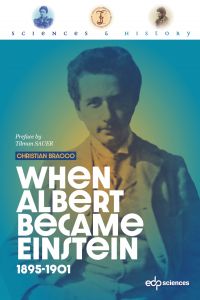When Albert became Einstein
Éditeur : EDP Sciences
ISBN numérique PDF: 9782759834815
Parution : 2024
Catégorisation :
Livres numériques /
Autre /
Autre /
Autre.
Formats disponibles
| Format | Qté. disp. | Prix* | Commander |
|---|---|---|---|
| Numérique PDF Protection filigrane*** |
Illimité | Prix : 39,99 $ |
*Les prix sont en dollars canadien. Taxes et frais de livraison en sus.
***Ce produit est protégé en vertu des droits d'auteurs.
Description
This book proposes an in-depth investigation carried out in Italy in young Albert Einstein's footsteps, since his attempt to enter the ETH Zurich in 1895 until his first doctoral work in 1901. We follow his family, who transferred his electrical engineering company from Munich to Milan, in the rich social, economic, political and industrial context of post-unified Italy; a milieu also familiar to Michele Besso, Albert's closest friend and collaborator, whom he met again daily in Milan on semester-breaks, after their first meeting in 1895. In Pavia, the parish register will lead us to Carlo Marangoni, the uncle of Ernestina (Albert's friend) and a specialist in capillarity phenomena. In Milan, we will discover the library of the Lombardo Institute, Academy of sciences and letters, where Albert worked for his bibliography. Old registers at the university and at the Polytechnic will draw our attention to his connection with Giuseppe Jung, one of Michele's uncles, an academician. This young Albert environment sheds a new light on his scientific remarks to his fiancée Mileva Marié: his first article on capillarity and molecular forces; his interest in wireless telegraphy; his search to evidence the motion of the Earth through the ether; his thesis extended to weakly compressed gases and even his early questionings on the nature of light. All of this we will discover in a trip round Lombardy in the beginning of the 19th century.























